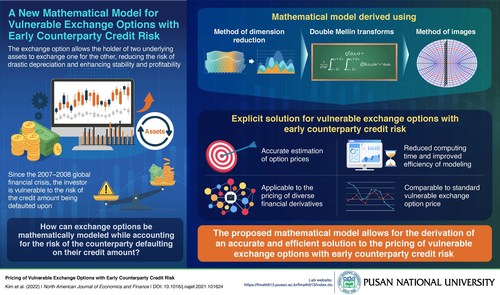BUSAN, South Korea, Feb. 2, 2022 /PRNewswire/ — The exchange option is one of the most popular strategies to avoid the drastic depreciation of assets in the over-the-counter (OTC) market. With the exchange option, the holder of two underlying options (assets) can exchange one for the other. But predicting the prices of options has become difficult since the global financial crisis in 2008. Now, researchers have developed a new model to effectively price vulnerable exchange options for successful portfolio asset allocation.
The global financial crisis in 2007–08 devastated markets worldwide and created a sea change in how we conduct finance. The over-the-counter (OTC) market has flourished in the aftermath of the global financial crisis. In an OTC, two parties can directly trade stocks, commodities etc. with each other and without the use of a central exchange or broker. This has, however, made the option holder permanently open to default risk. Modeling the prices of these options in the OTC market is complicated, with most existing models falling short. In a new study, published in North American Journal of Economics and Finance, researchers suggest a way to effectively and accurately price vulnerable options while accounting for the risk of the counterparty defaulting on their commitment, i.e., counterparty credit risk. "The exchange option enables its option holder, who holds two underlying assets, to exchange one asset for the other. But when does one apply this strategy? That is what we have aimed to answer in our work," says Prof. Ji-Hun Yoon, Associate Professor at Pusan National University, who led the study.
The exchange option offers a means by which an investor can improve the performance of risk adjustment, as well as mitigate the risk of drastic portfolio depreciation. This is crucial when an investor holds risky assets. The exchange option allows the investor to offset the risk and allows them to aim towards more stability and profitability.
For their model, the research team used three key mathematical techniques—the ‘method of dimension reduction,’ ‘double Mellin transforms,’ and the ‘method of images.’ By applying these complicated techniques, they were able to derive an explicit-closed form solution to the problem of vulnerable exchange option pricing. The primary advantage of an explicit solution lies in the efficacy of its final calculations, enabling its quick deployment without the need to wait for long calculations on a computer. The research team then compared their model to the standard vulnerable exchange option (VEO) model and found their results to be sufficiently similar. Finally, they confirmed the accuracy of their result by checking it against the formula derived using ‘Monte-Carlo simulation,’ which is a computationally intense but accurate method.
"Pricing the model dynamics of financial derivatives in a way that reflects the current situation in the OTC market is very important," explains Prof. Yoon. "Our work can be applied to the pricing of diverse financial derivatives and enable effective portfolio allocation."
These findings are sure to have a significant effect on how people choose to invest and manage their portfolios in the future.
Reference
Title of original paper: Pricing of Vulnerable Exchange Options with Early Counterparty Credit Risk
Journal: The North American Journal of Economics and Finance
DOI: https://doi.org/10.1016/j.najef.2021.101624
*Corresponding author’s email:
328913@email4pr.com
Lab: https://fmath613.pusan.ac.kr/fmath613/index.do
About Pusan National University
Website: https://www.pusan.ac.kr/eng/Main.do
Contact:
Na-hyun Lee
+82 51 510-7928
328913@email4pr.com
SOURCE Pusan National University


